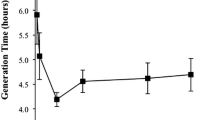Abstract.
Salinibacter ruber is a red obligatory aerobic chemoorganotrophic extremely halophilic Bacterium, related to the order Cytophagales. It was isolated from saltern crystallizer ponds, and requires at least 150 g l–1 salt for growth. The cells have an extremely high potassium content, the ratio K+/protein being in the same range as in halophilic Archaea of the order Halobacteriales. X-ray microanalysis in the electron microscope of cells grown in medium of 250 g l–1 salt confirmed the high intracellular K+ concentrations, and showed intracellular chloride to be about as high as the cation concentrations within the cells. A search for intracellular organic osmotic solutes, using 13C-NMR and HPLC techniques, showed glutamate, glycine betaine, and N-α-acetyllysine to be present in low concentrations only, contributing very little to the overall osmotic balance. The results presented suggest that the extremely halophilic Bacterium Salinibacter uses a similar mode of haloadaptation to that of the Archaea of the order Halobacteriales, and does not accumulate organic osmotic solutes such as are used by all other known halophilic and halotolerant aerobic Bacteria.
Similar content being viewed by others
Author information
Authors and Affiliations
Additional information
Electronic Publication
Rights and permissions
About this article
Cite this article
Oren, A., Heldal, M., Norland, S. et al. Intracellular ion and organic solute concentrations of the extremely halophilic bacterium Salinibacter ruber . Extremophiles 6, 491–498 (2002). https://doi.org/10.1007/s00792-002-0286-3
Received:
Accepted:
Issue Date:
DOI: https://doi.org/10.1007/s00792-002-0286-3




